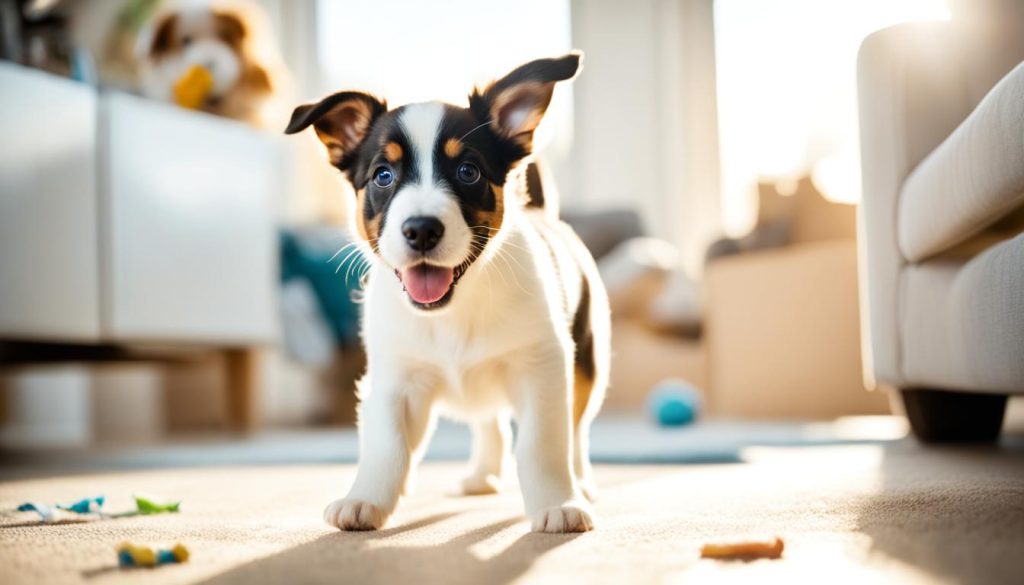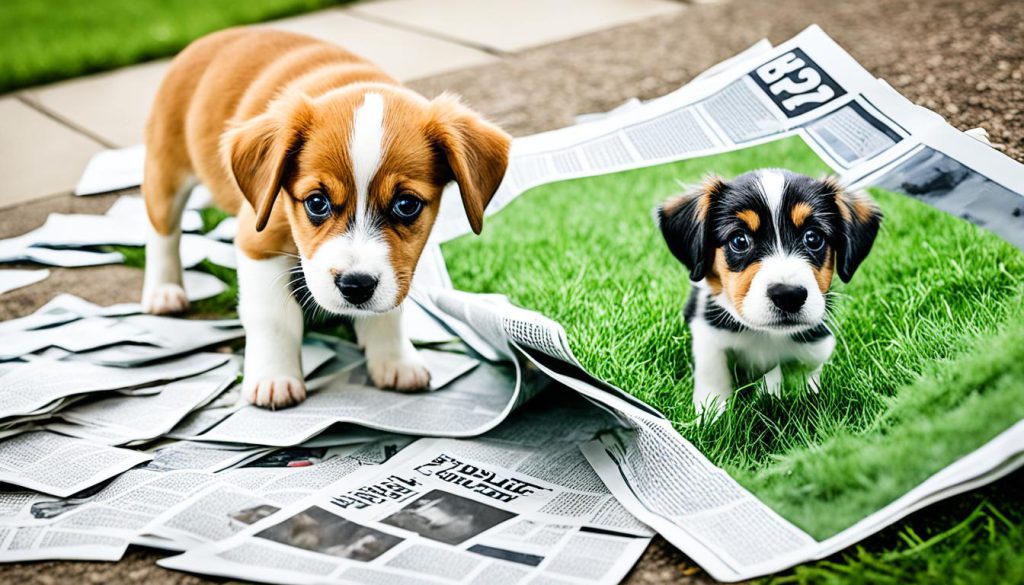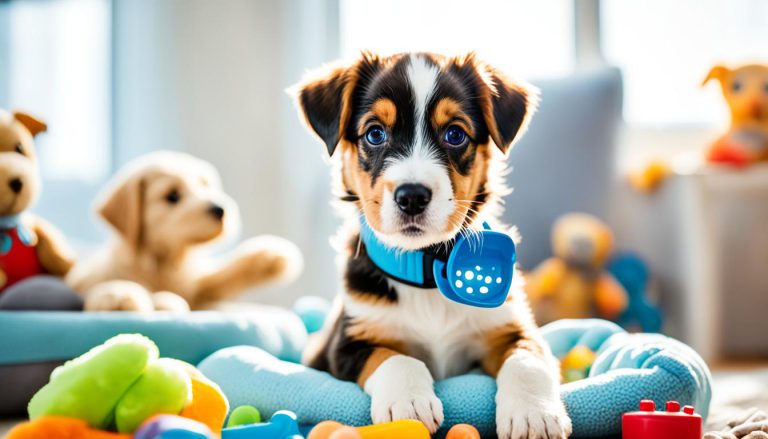Getting a new puppy is very exciting, filled with joy and love. I can’t forget the day I met my pup, feeling like I added to my family. Yet, taking care of a puppy is a big job. From their first day with you to their first year, each moment matters for their health and happiness. You must be ready in every way for what’s coming.
Puppies have special needs that are important to understand. They usually eat three times a day and need to go out every 45 minutes while awake. A regular schedule helps them feel safe and makes house training easier. Puppies also need lots of sleep, around 16 to 18 hours, so a cozy sleeping spot is key.
Being flexible is important in the first few months. By 4 to 5 months, most puppies stop needing breaks in the night. Yet, you need patience and to stick to your routine. You also have to deal with chewing and accidents calmly and with clear rules. These moments help build a strong bond and trust.
Vets say this bonding time is critical. They recommend positive training to raise obedient, happy dogs. Being ready for anything, like flea prevention or puppy-proofing your home, is all part of being a good pet owner. The first year will test you, but also bring joy as your puppy grows into a faithful friend.
Key Takeaways
- Ensure young puppies eat three times a day to meet their nutritional needs.
- Puppies need to eliminate frequently, especially every 45 minutes when awake.
- Most puppies may sleep 16 to 18 hours each day, requiring a safe and comfortable space.
- Around 4 to 5 months old, puppies typically do not need middle-of-the-night potty breaks.
- Establishing a structured routine helps puppies feel secure and understand their expectations.
Preparing Your Home for a New Puppy
Getting a new puppy is very exciting. But you need to be ready for it. Making your home safe for the puppy is key. I’ll show you how to do this. We’ll cover how to make your home puppy-proof, what supplies you need, and how to set up a safe area for them.
Puppy-proofing Your Home
Making your home safe for a puppy is much like doing it for a small child. You have to check your home for dangers. A good list can help you make sure that harmful things are away from your puppy. Many people use gates or sprays to keep puppies safe. Checking your home often is also very important.
Gathering Essential Supplies
A lot of puppy owners buy all their supplies at once. It’s important to have the right supplies ready. These include crates, bowls for food and water, grooming tools, and cleaning supplies. Puppies eat about 200-300g of food daily, so get the right food. Things like baby gates help keep puppies out of certain areas.
Setting Up a Safe Space
It’s important to create a safe spot for your puppy. A crate with a comfy bed and toys is great. Nearly 75% of pet owners visit a vet in the first week. This is to make sure the puppy gets a healthy start. Regular vet visits and vaccines are important.
Here’s what you need and what to do for your puppy’s health:
| Essential Supplies | Health Measures |
|---|---|
| Crate | Regular Vet Appointments |
| Food and Water Bowls | Vaccinations |
| Puppy Food | Heartworm Protection |
| Grooming Tools | Topical Flea and Tick Repellents |
| Cleaning Supplies | Daily Health Checks |
By puppy-proofing your home and getting the right supplies, you’re making a safe place for your puppy. Enjoy being a puppy parent!
Introducing Your Puppy to Its New Home
Bringing a new puppy home is a thrilling time. But, it’s key to smooth their way into this big change. Puppy introduction to home should ease their worries and make them feel secure.

Gradual Introduction to Family Members
Start by letting your puppy meet one family member at a time. It prevents them from feeling swamped. This step is crucial for puppy family introduction, helping them bond and get comfortable.
Make sure all meets with the family are supervised. Experts suggest introducing them to other pets on a leash. It keeps both pets safe and makes meeting each other better.
Establishing a Routine
Consistency with routines is crucial. A set schedule for eating, breaks, play, and sleep sets clear expectations. Nightly and early morning potty trips will be needed, so plan for those.
Getting into a routine boosts their adjustment and joy. Sharing care duties amongst the family ensures well-rounded care. Clear rules teach them their dos and don’ts, encouraging good habits.
Providing Comfort and Security
For your puppy, feeling safe at home is top priority. Give them a cozy spot with good bedding for sleep. With puppies sleeping up to 20 hours, a peaceful spot is vital for their growth. A crate may be their comfort zone. Position it in a spot they can recognize easily, like the bedroom early on.
Keep your home puppy-safe. Make sure dangerous plants and foods are unreachable. Store food securely to prevent any sneaky accidents.
Being loving and supervising early on is vital. Play with them and show them love. It helps form a strong, happy bond with their new home.
With everyone’s help, your puppy will feel right at home, safe and loved.
Understanding Puppy Behavior
Learning about your puppy means knowing their habits and addressing any problems. By expecting realistic behaviors from your puppy, you and your pet can live happily.
Normal Puppy Behavior
Puppies are curious and like to play as they discover their world. They often chew, nip, and look for comfort as they learn. When new things scare them, it’s important not to cuddle them too much. Instead, teach them what behaviors are good.
Addressing Common Behavioral Issues
To fix puppy problems, you need to be consistent with rules and how you respond. For example, with biting, be firm but gentle. Give them special toys to chew on instead of household things. This helps them learn what behaviors are okay.
Using Positive Reinforcement
Positive reinforcement training is great for teaching good behaviors. Use methods like luring, capturing, and shaping. Luring gets them to act right with treats. Capturing praises them when they’re already doing something well. A clicker or word tells them they did something right. Shaping rewards them as they get closer to the goal.
Start training where there aren’t many distractions. Slowly add more distractions. Use cues, like words or gestures, to let them know a reward is coming for the right behavior. This encourages good behavior, making them well-behaved pets.
Basic Puppy Training Tips
Training a puppy early leads to good behaviors and a strong owner bond. Let’s explore key tips for puppy potty training, teaching basic puppy commands, and crate training techniques. These support puppy obedience training.
Potty Training
Potty training a puppy needs patience and a routine. Even puppies as young as 8 weeks old can learn where to go potty. Start by picking a specific spot outside for them to use. Take them there a lot, like after eating, sleeping, and playing. Reward them when they do it right with treats or kind words. Don’t punish accidents. Focus on being consistent and positive instead.

Basic Commands and Obedience
Teaching basic puppy commands like “sit,” “stay,” and “come” is vital. Start in a calm place to keep them focused. Make lessons short and fun, and play with them to keep their interest. For teaching commands, use capturing by rewarding when they do the behavior on their own. Also, use luring by guiding them with treats to the right position. Success comes from being consistent and positive.
Crate Training
Crate training techniques help puppies view their crate as a safe place. Make the crate cozy with soft bedding and introduce it slowly. Begin with short crate times, then gradually longer as they get used to it. Crate training is essential for puppy potty training and helps create a toileting routine. It also helps puppies become independent and gives them a secure space.
Using these methods and staying positive and consistent leads to a well-trained, obedient, and joyful puppy.
Puppy Nutrition: Feeding Your Puppy
Getting your puppy the right nutrition is key for their growth. It’s about picking the best food, setting a feeding schedule, and giving healthy treats and supplements.
Choosing the Right Food
Ask your vet about the best puppy food. What’s right depends on your puppy’s breed, age, and size. Puppy food should have the nutrients they need for fast growth. For example, food for large-breed puppies has less calcium and phosphorus to manage their growth.
Start puppies on solid food at four weeks. They should slowly move from mother’s milk to puppy food. Go for premium dog food that’s nutrient-rich. This means you can give smaller amounts. But avoid chocolate, grapes, and onions. These can hurt dogs.
Feeding Schedule
A puppy feeding schedule is important. Feed them three times a day until they’re about six months. Then feed them twice a day. Young puppies need more calories than adult dogs of the same breed. Watch your puppy’s weight and adjust how much you feed them to keep them healthy.
Switch to adult food when they’re nearly grown. This is around 7-9 months for small breeds. For larger breeds, it could be 12-14 months. Change their diet slowly to avoid stomach issues.
Treats and Supplements
Treats can help with training. They should be less than 10% of what your puppy eats every day. Use healthy puppy treats and skip table scraps. Carrots and green beans are good choices.
Sometimes, puppies need extra vitamins or minerals. Always talk to your vet before giving any puppy dietary supplements. This ensures they’re needed and safe for your puppy.
| Feeding Stage | Feeding Frequency | Notes |
|---|---|---|
| Weaning – 6 months | Three times daily | High-calorie intake needed for growth |
| 6 – 12 months | Twice daily | Transition to twice-a-day feeding |
| 7 – 9 months (small breeds) | Twice daily | Transition to adult food |
| 12 – 14 months (large breeds) | Twice daily | Transition to adult food |
Puppy Socialization
Puppy socialization is key to raising a happy and confident dog. It helps your puppy get used to many different things. This builds a positive and strong temperament.
Why Socialization is Important
Every dog owner should understand the importance of puppy socialization. A socialized puppy is less likely to be anxious or aggressive. The critical period for socialization is between 3-12 weeks. This is when puppies are most open to new things. By exposing puppies to new experiences early, they grow to be more confident.
Introducing Your Puppy to New Experiences
Introducing puppies to new things should be done gently and slowly. In the first two weeks, puppies rely fully on their mom. From 2-4 weeks, as they start to see and hear, they get ready for more socializing. By the time they’re 3-6 months old, they should face different places, sounds, and people. This helps them learn to deal with all kinds of situations.
Socialization with Other Dogs
Socializing with other dogs is crucial for a puppy’s learning. Meeting other dogs regularly builds their confidence and lowers fear. From 3 to 6 months, puppies learn a lot that affects their future actions. Keeping up with socializing through their youth, up to 18 months, is also important. Activities like playdates and dog park visits are great for safe interactions. They help your puppy learn how to behave around other dogs.
In sum, giving your puppy many social experiences and chances to meet others makes for a well-behaved adult dog.
The Importance of Puppy Vaccinations
Vaccinating your puppy is key to a healthy start. It shields them from serious, sometimes fatal diseases. It’s crucial for their health care.
Core Vaccinations
Vets require core vaccines for puppies. These include shots for parvovirus, distemper, hepatitis, and rabies. They protect not just your puppy but also people, since rabies can spread to humans. The American Veterinary Medical Association stresses their importance for preventing outbreaks.
Vaccination Schedule
It’s vital to follow a vet’s vaccine schedule for puppies. They should get their final shots by four months. Then, booster shots every few years maintain their immunity. Laws sometimes mandate vaccinations for all pets, including those that live indoors.
| Age | Recommended Vaccines |
|---|---|
| 6-8 weeks | Distemper, Parvovirus |
| 10-12 weeks | DHP, Bordetella |
| 14-16 weeks | Rabies, Leptospirosis |
| Annually | Booster Shots |
Dealing with Side Effects
Managing side effects is part of vaccinating. Serious reactions are rare, but watch for allergies. Signs include fainting or breathing trouble. Mild symptoms like tiredness or soreness where the shot was given are more common. Contact your vet right away if serious issues occur. Many pet care places demand vaccines to keep all animals safe.
With proper vaccines, a strict schedule, and watching for reactions, your puppy will be well-protected. These efforts help fight diseases in pets and obey the law. They also support animal health worldwide.
Regular Exercise for Puppies
Regular exercise is very important for a puppy’s growth. It helps both their body and mind. Make sure the exercise fits their breed and watch them closely.
Types of Exercise for Different Breeds
Different puppies need different types of exercise. For instance, a Border Collie loves to run a lot. But a Bulldog does better with short walks because of breathing problems. Big dogs, like Great Danes, need special exercises to keep their joints healthy.
Fun Activities to Keep Your Puppy Active
There are lots of fun activities for puppies. Playing fetch and interactive games are great. They also love doing things that match their natural instincts, like herding. Mental games, like puzzle toys, keep their minds sharp and prevent boredom.
Signs of Over-exercising Your Puppy
It’s important to know when your puppy is exercising too much. Signs include limping, not wanting to move, breathing hard, or getting too tired. Too much exercise can hurt their bones and joints. Always increase their exercise slowly and avoid hard activities until they’re grown.
Talking to your vet can help make a good exercise plan for your puppy. This ensures they grow up healthy and happy. Exercise helps prevent weight problems and teaches them good behaviors.
Puppy Grooming Essentials
Keeping your furry friend healthy and happy starts with proper grooming. This includes brushing and nail trimming regularly. We’ll guide you through grooming your puppy, covering bathing tips, nail trimming, and dental care.
Bathing and Brushing
Bathing regularity is key for your puppy’s skin and coat health. Some shampoos, like Wahl’s Four in One Dog Shampoo, also have a conditioner. This helps untangle mats and keep the skin moisturized. Use tips that match your breed for the best bathing technique and frequency.
For smooth, short coats, curry-type brushes work best. Slicker brushes are great for longer coats to avoid mats and tangles. Picking the wrong brush can cause your dog discomfort or lead to infections.
Grooming keeps your dog looking and feeling great. For long-coated dogs, we recommend metal grooming combs. Grooming sprays help with static, detangling, and leave a nice smell.
Nail Trimming
Nail trimming is vital to your puppy’s grooming. It prevents discomfort and mobility problems. We suggest clipping nails monthly. This will shorten the quick, which reduces bleeding or pain if you cut too short.
Plier-style nail clippers are best for a safe trim. Always keep styptic powder ready to stop any bleeding. Look for a clipper that can handle thick fur easily.
Ear and Teeth Cleaning
Keeping ears and teeth clean avoids infections and keeps your puppy healthy. Cleaning ears regularly prevents wax and infections. Start brushing teeth early with gentle motions.
Use dog-specific brushes and toothpaste for the best results. Puppies’ noses are very sensitive to smells, so choose mild products designed for them.
“Applying a monthly flea and tick preventive helps keep pets safe from these pests.”
Choose a gentle dog shampoo instead of human shampoo. It’s milder for your pup. Drying properly after baths is important too. This avoids tangling and infections, especially when it’s cold. Use dog dryers for thick coats, but never human hair dryers. Dog bath wipes are a convenient choice for quick clean-ups.
| Grooming Tool | Ideal For |
|---|---|
| Curry-type brush | Smooth, shorter coats |
| Slicker-style brush | Longer, thicker coats |
| Steel grooming comb | Long-coated dogs |
| Plier-style nail clippers | Safe nail trimming |
| Dog-specific toothbrush and toothpaste | Puppy dental care |
With these grooming practices, your puppy stays healthy and happy. Plus, they’ll always look their best.
Puppy Care: Ensuring Healthy Growth
To ensure your puppy grows up healthy and strong, focus on regular vet checks and preventive care. Watching their growth closely helps spot any health problems early. This promotes their overall well-being.
Regular Vet Visits
It’s crucial to take your puppy for puppy vet visits regularly. Such visits allow the vet to monitor your pup’s growth and overall health. They also keep track of your puppy’s development and ensure they get their vaccines on time. Vaccines are essential for protecting against serious diseases.
Preventive Health Measures
Preventive care is key to dodging common health issues in puppies. This means starting them on heartworm prevention by 8 weeks old and keeping up with it as your vet recommends. Protecting your pup from fleas and ticks is also important. Plus, getting them spayed or neutered at the right time is a smart preventive step.
Monitoring Growth and Development
Keeping an eye on your puppy’s growth ensures they hit the right milestones. This includes monitoring their weight gain and observing their learning and behavior. Switching from puppy to adult dog food should be done carefully, based on their growth. Regular brushing and frequent bathroom breaks are also part of good puppy care.
| Health Measure | Recommended Timing |
|---|---|
| Vaccination (DHPP, etc.) | Starts at 6 weeks |
| Heartworm Prevention | Starts at 8 weeks |
| Spaying/Neutering | 6-12 months |
| Frequent Vet Visits | Throughout First Year |
Giving consistent care through all stages of your puppy’s life makes sure they grow up happy and healthy. Paying attention to puppy vet visits, preventive health for puppies, and growth monitoring lays a strong foundation for your pet’s future.
Conclusion
Taking care of a puppy is rewarding but requires a lot of hard work. As new dog parents, it’s important to know what you’re signing up for. This helps create a happy and healthy friend.
First, make your home safe for the puppy and get all the needed items. Early steps are crucial for good dog parenting.
Making sure your puppy is healthy is key. Regular vet visits and a good diet are important. So is teaching them right from wrong with kindness. Playing with your puppy keeps them active and smart.
Getting a puppy is fun but takes effort. Finding the right balance is important for raising a joyful puppy. Expert advice and true commitment to their care set the stage for a great dog parenting journey. It leads to a strong bond and years of friendship.
Source Links
- https://www.akc.org/expert-advice/health/first-day-new-puppy/
- https://www.akc.org/expert-advice/home-living/preparing-new-puppy/
- https://1stpetvet.com/5-tips-for-preparing-your-home-for-a-new-puppy/
- https://www.purina.com/articles/dog/puppy/getting-a-puppy/introducing-new-puppy
- https://www.webmd.com/pets/dogs/bringing-home-new-puppy
- https://www.akc.org/expert-advice/training/8-tips-to-help-your-new-puppy-adjust-to-new-home/
- https://vcahospitals.com/know-your-pet/puppy-behavior-and-training-training-basics
- https://be.chewy.com/basic-puppy-training/
- https://www.akc.org/expert-advice/training/teach-your-puppy-these-5-basic-commands/
- https://www.webmd.com/pets/dogs/puppy-food-types
- https://www.akc.org/expert-advice/health/puppy-feeding-fundamentals/
- https://vetmed.tamu.edu/news/pet-talk/puppy-socialization/
- https://www.avma.org/resources-tools/pet-owners/petcare/vaccinations
- https://www.pdsa.org.uk/pet-help-and-advice/looking-after-your-pet/puppies-dogs/exercising-your-puppy
- https://www.hillspet.com/dog-care/play-exercise/puppy-exercise
- https://www.akc.org/expert-advice/training/keep-your-puppy-active-and-out-of-trouble-with-stimulation-and-exercise/
- https://wahlusa.com/expert-advice/grooming-pets/7-dog-grooming-essentials-every-pet-owner-needs
- https://www.luckypuppygrooming.com/basic-dog-grooming-supplies-every-dog-owner-needs/
- https://www.splootvets.com/post/puppies-101-the-ultimate-pet-parents-guide
- https://www.rspca.org.uk/adviceandwelfare/pets/dogs/health/puppycare
- https://www.pdsa.org.uk/what-we-do/pdsa-animal-wellbeing-report/paw-report-2022/conclusion
- https://pawhavenhutto.com/5-essential-tips-for-proper-puppy-and-kitten-care/
- https://www.aaha.org/aaha-guidelines/behavior-management/conclusion/

